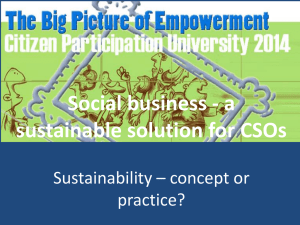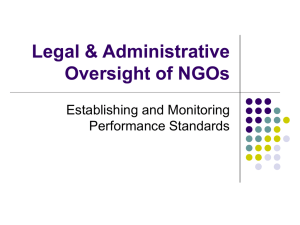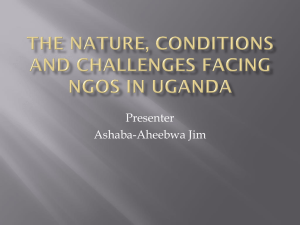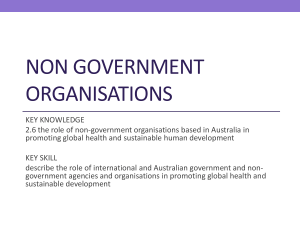Accountability Without Impact? Or What Impacts Should
advertisement
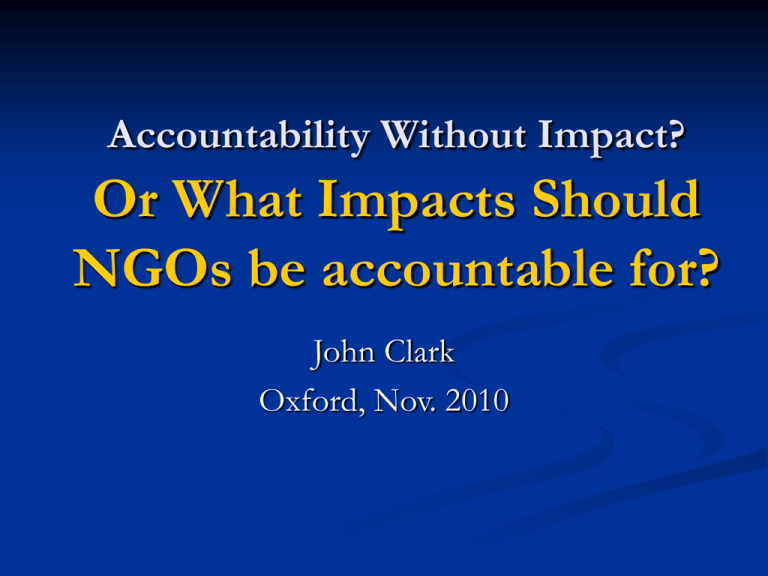
Accountability Without Impact? Or What Impacts Should NGOs be accountable for? John Clark Oxford, Nov. 2010 Context - Funding trends 1980s – steep increase in support for NGOs 1990s – steep increase in official grants USG accounted for 70% of US NGOs’ aid by late 90s 2000s – steep increase in CSO delivery of ODA NGO service agents in big donor programs to deliver MDGs, Increase in Community-Driven Development via CBOs Recently – steep rise in business philanthropy Private giving $49bn in OECD; ODA=$104bn USG funding for US-NGOs down to 30% Trends (cont’d) Steep increase in numbers of NGOs UK now has 7270 int’l charities, sharing £2.1bn Growth of bijou charities Very specific concerns, e.g. IBP, WWB, PTF, Tiri The “My Cause” age: NGOs that allow a donor to pick their winner KIVA, Ashoka, Global Giving etc So – it may be that the same questions surface now about M&E as in 1980s, but different people are asking the questions Who is assessing NGO performance? A. Professional NGO development evaluators: who ask the sort of questions in the background paper B. Bilateral agency evaluators: who ask about Effectiveness, Efficiency, Relevance and Sustainability C. Philanthropy guides: who ask about the bottom line and business efficiency. What gets measured gets managed. But B and C influence the world in which A work Business analogy What do investment analysis measure? Productivity Price advantage compared with rivals Market share, and changes in this Profits Market trends (consumer patterns, world affairs…) They DON’T measure quality of products because this is best judged by the market – by choice of citizens as consumers In our world, what is the market? Poor communities? They rarely have choice. The donors choose – by what measures? Efficiency indicators for DFID DFID Business Plan 2011-2015, November 2010 cost of running DFID; numbers of employees, % of costs due to “corporate services” (overheads) …and for “3rd party spend”: property costs per sq. m and per employee cost and number of computers per employee Value of major areas of spending (office products, travel etc.) No./value of govt. projects; if delivered to time/budget DFID Input Indicators Cost per child supported in primary education Cost per bed net distributed Cost per sanitation facility (e.g. toilet, sewer) built or upgraded Cost of building, upgrading, maintaining or rehabilitating roads DFID spend on fighting corruption Cost per birth delivered by nurses, midwives or doctors DFID spend on climate change DFID spend on multilateral organisations DFID-achieved impact indicators No. children completing 5yrs primary education No. bed nets distributed No. sanitation facilities built/upgraded Km. roads built, upgraded, maintained etc Worldwide Governance Indicator (corruption level) No. births with help of nurses/midwives/doctors No. poor people better able to cope with climatic shocks NGO ratings agencies American Institute of Philanthropy Service to help donors find “top-rated charities based on our rigorous analysis” RATING CRITERIA: % budget spent on charity’s declared purpose Cost of raising $100 Years of available assets Charity Navigator More elaborate set of SEVEN criteria: % NGO expenditures spent on programs Administrative expenses Fundraising expenses Fundraising efficiency Primary revenue growth Program expense growth Working capital ratio None relate to the QUALITY of the programs CN is now changing – to focus on Social Impact NGO governance The contagious effect of scandals (Unicef-Germany) Pressure for transparency (2-way) Focus on boards’ independence/professionalism Growing no. of codes of conduct (OneWorld database) Self-policing mechanisms (by trade assocs. e.g. InterAction) The Age of Measurement NGOs are increasingly assessed quantitatively What can be measured may not be most important Advocacy, complex systems change, empowerment etc are traditionally seen as qualitative domains But this doesn’t mean success can’t be assessed MAXIM: find ways to COUNT what counts! The client is the poor family, not the donor In Operational Programs Scant literature on impact of NGO projects Lacuna interpreted as grounds to doubt NGO roles 10 health progs, comparison with state services: clear NGO benefits: immunization up 11-21%; malnutrition rates down 18%; TB cure rate ↑ 14%, cost 15% PHC outsourcing in Uganda: better care, 28% cheaper, more motivated staff, better in detecting malaria, etc. Meta-analysis, 7 countries in education: completion rates 74%, c.f. 59% in govt. schools; pass rates 67%, c.f. 37%; cost per completer was 2.8 x higher in govt. schools Shouldn’t be either/or – CSOs as co-providers: HIV/AIDS services in hard-to-reach groups; child/mother nutrition In participatory development Harder to assess, but not impossible (few do it!) Social accountability impact KDP in Indonesia – combine CSOs + audits Social Audits in NREGA, India (AP, Rajasthan) Constituency Voice: Satisfaction, Ownership, Trust (Keystone) Reducing errors and budget leaks Reducing bad procurement processes Improving quality and responsiveness of public services Advocacy impact Combating discrimination against women, Bangladesh Stemming forestry concessions, Cambodia Assessing social impact Robert Chambers view “Intensifying paradigmatic tug-of-war” A. Top-down, donor-driven and bureaucratic … targets set from above, donors with log frames, objectively verifiable indicators, impact evaluation in its cruder forms … reporting upwards on achievements B. Local diversity, differing values and evolving goals, and methodological pluralism and inventiveness Participatory, more egalitarian, more flexible, concerned with what is less tangible and less measurable like relationships, and often with trust, empowerment and people. e.g. 1 – Government Watch, Philippines Pinpointing corruption and inefficiency; Education Highlighting the problem won official allies “Textbook Walk” – revealed culprits Reforms reduced costs by 55%, time by 63% Boy Scouts empowered – Governance Camp World Scouts gathering – 2000 joined governance camp Every step could be documented, measured and returned to for long-term impact e.g. 2 – Use of devolved funds, Kenya CRSP had supported village devel. for years CBO structure, with AKF support services With ↑ in devolved funds, strategy changed CBOs linked in clusters, federated at District level Negotiation achieved with LGUs, councilors CBO Monitoring of selected projects RESULTS: more poor-focused projects, more successful implementation, less un-spent funds, better local govt. But no-one is monitoring these issues; supported by PPA, DFID more concerned with “VfM” N and S NGOs are in same boat Not true that there is “clear breakdown in trust” Issues may be ones discussed 20 yrs ago, but doesn’t mean they were solved or are insoluble Participation never went out of fashion Interest in randomized trials is an interest in showing results – reasonable in a $50bn industry Conclusions We can sneer – but this is the age of “counters” Can’t beat ‘em, so need to join ‘em Randomized trials can be effective (e.g.MIT-PAL) Other approaches can also document progress Needn’t be cynical; one experience is a story “Anecdote” is an irregular noun CSOs need to be challenged, but not changed Academics, M&E specialists need to work with NGO planners; to help quantify their outcomes MAXIM: find ways to COUNT what counts! The client is the poor family, not the donor
